

Four ‘Oscars of Invention’ for Berkeley Lab With This Year’s R&D 100 Awards
Daya Bay Underground: In Search of Theta One Three
Four ‘Oscars of Invention’ for Berkeley Lab With This Year’s R&D 100 Awards
The envelope, please! And the winners are:
- The Carbon Explorer, starring James K. Bishop of Earth Sciences;
- A High-Efficiency Multiband Semiconductor Material for Solar Cells, starring Wladyslaw Walukiewicz and Kin Man Yu of Materials Sciences;
- The Laser Ultrasonic Sensor, starring Rick Russo and Paul Ridgway of EETD;
- The High-Output Coaxial-Target Neutron Generator, starring Ka-Ngo Leung and Jani Reijonen of AFRD and Frederic Gicquel and Stephen Wilde of Engineering.
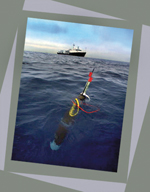
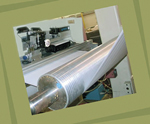
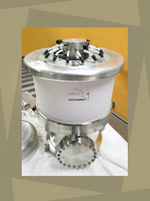
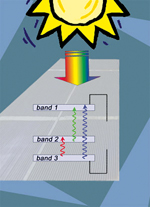
R&D 100 winners, clockwise from upper left: the Carbon Explorer, the Laser Ultrasonic Sensor, High-Efficiency Multiband Semiconductor Material for Solar Cells, and the High-Output Coaxial-Target Neutron Generator.
It was the Chicago Tribune that coined the snappy phrase “Oscars of Invention,” and every year the R&D 100 Awards, inaugurated by R&D Magazine in 1963, are treated more and more like real Oscars by DOE’s national labs, who compete for them like rival movie studios. Proportional to size and number of entries, Berkeley Lab’s four awards for 2006 may be the equivalent of Best Picture.
“Winning four awards, given the size of our Lab, is a tremendous achievement and speaks very highly of the strength of our science and its relevance to solving complex global problems,” says Cheryl Fragiadakis, head of the Lab’s Technology Transfer and Intellectual Property Management Department. The 2006 awards, the most the Lab has won in a single year since 1987, bring Berkeley Lab’s total haul to 41, with three of this year’s four technologies in commercial development.
The Winning TechnologiesOceanographer Jim Bishop led development of the Carbon Explorer to continually measure carbon biomass and carbon flux at depths up to two kilometers, then report via satellite, independent of research vessels. Carbon Explorers are based on autonomous SOLO floats originally developed at the Scripps Institution of Oceanography; WET Labs of Oregon aided in instrumentation.
Carbon Explorers provided the first observations of natural fertilization of a plankton bloom in the North Pacific by a dust storm in Central Asia and were first to record evidence of carbon exported to ocean depths by artificially fertilized plankton in the Southern Ocean, operating through the Antarctic winter; they operated for months in the North Atlantic to record coccolithophore blooms. The research payoff, already momentous, promises to become ever more significant.
A High-Efficiency Multiband Semiconductor Material for Solar Cells was created by Wladek Walukiewicz and Kin Man Yu by splitting the band gap of zinc manganese tellurium (ZnMnTe). Sunlight spans energies all the way from low-energy infrared to high-energy ultraviolet, but the band gaps of most photovoltaic materials respond to only a narrow slice of the spectrum; a typical silicon cell is only 15 percent efficient.
Walukiewicz and Yu doped ZnMnTe with oxygen to produce three widely split bands. Energy differences between the two split bands, between the valence band and lower split band, and between the valence band and the upper split band form gaps responsive across the solar spectrum, with remarkable 63 percent efficiency. Four-band materials now in development could reach 73 percent efficiency.
Rick Russo and Paul Ridgway developed the Laser Ultrasonic Sensor in collaboration with Georgia Tech’s Institute of Paper Science and Technology to improve efficiency of paper manufacture. The new sensor measures quality on the fly at 30 meters per second, so it’s no longer necessary to test and maybe scrap three-ton paper rolls after they’re made.
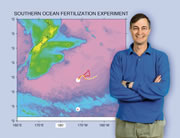
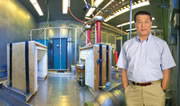
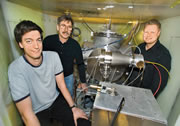
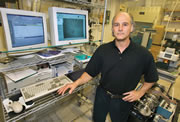
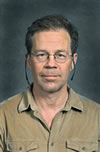
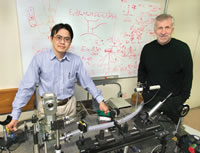
Berkeley Lab’s R&D 100 Award winners (clockwise from upper left): Jim Bishop; Ka-Ngo Leung; Frederic Gicquel, Stephen Wilde and Jani Reijonen; Kin Man Yu and Wladek Walukiewicz; Paul Ridgway and Rick Russo
A detection beam travels with the moving paper; a nanosecond pulse from a laser causes thermal expansion, too small to mar the paper but strong enough to send out ultrasonic shock waves, registered by the detection beam. The time it takes the ultrasonic shock waves to propagate through the paper depends on its stiffness and shear rigidity. Once the technology is widely in place, savings could reach hundreds of millions of dollars annually.
The High-Output Coaxial-Target Neutron Generator developed by Ka-Ngo Leung and Jani Reijonen of the Accelerator and Fusion Research Division and Frederic Gicquel and Stephen Wilde of the Engineering Division is small enough to be used in a laboratory or clinical-treatment setting, while generating neutron flux comparable to the experimental stations of large accelerators.
A rod-shaped source emits beams of heavy hydrogen ions radially along its length; the target, a layer of titanium bonded to water-cooled copper, is wrapped around the source. Since the hydrogen is continually loaded onto the titanium, the target cannot be depleted. Deuterium-deuterium fusion releases a hundred billion neutrons per second; tritium-deuterium beams yield even more. The generator is currently being tested as a treatment for brain cancer at the University of Turin, Italy.
The R&D 100 Award-winning technologies were nominated by Berkeley Lab’s Technology Transfer Department. The winners of the 2006 award will receive a plaque at R&D Magazine’s formal awards banquet in Chicago on October 19.
Daya Bay Underground: In Search of Theta One Three
Neutrinos have mass — but only a little, and nobody knows exactly how much. Of the three neutrino flavors (electron, muon, and tau neutrino), the heaviest has at least one 10-millionth the electron’s mass and could have more than 10 times that much. But which flavor is the heaviest? That too is uncertain.
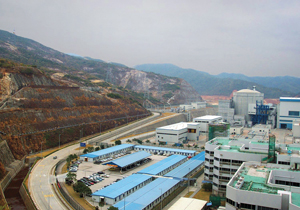
The reactors at Daya Bay are among the world’s most powerful. Antineutrino detectors will be placed in tunnels in the nearby mountains.
To learn the answers — and get a start on other fundamental questions, such as how electrons and their relatives came into existence after the Big Bang and why there is more matter than antimatter in the universe — scientists need to determine the value of a term referred to as “neutrino mixing angle theta one three.”
To pin down the value of theta one three with high precision, Kam-Biu Luk of Berkeley Lab’s Physics Division, a leader in neutrino studies who is also a professor of physics at UC Berkeley, and his colleagues in China, the U.S., and other countries are planning to make use of the powerful nuclear reactors at China’s Daya Bay.
The project will require three kilometers of tunnels drilled under granite mountains hundreds of meters high. In chambers shielded from cosmic rays by the overlying rock the researchers will install eight identical antineutrino detectors that can be rolled from location to location inside the tunnel system. Each weighs 100 metric tons and carries scintillator-filled acrylic vessels nested like Russian dolls inside steel tanks lined with photomultiplier tubes. The massive instruments are designed to detect the rare inverse beta decays that occur when electron antineutrinos from the reactors slam into protons in the scintillator, yielding neutrons and positrons.
Berkeley Lab leads the U.S. participation in Daya Bay, with the Lab’s associate director for general sciences, James Siegrist, representing Berkeley Lab in international talks. The Daya Bay experiment’s scientific spokespersons are Berkeley Lab’s Luk and Yi-Fang Wang of the Institute of High Energy Physics in Beijing.
Bill Edwards of the Lab’s Engineering Division is the U.S. Project Manager overseeing construction of the experiment; Karsten Heeger of Physics is a member of the Daya Bay scientific team, and Joe Wang and Pat Dobson of Earth Sciences aided the geological survey.
Scores of U.S. and Chinese personnel have joined with colleagues in Russia, Taiwan, and the Czech Republic — more than 20 institutions in all. The Chinese Academy of Sciences has led the way in committing funds to the project, with other Chinese funding agencies and regional governments following suit.
“The Department of Energy wants to make Daya Bay happen,” says Siegrist. DOE is sponsoring U.S. research and development, with a review scheduled for November, 2006 to establish the basis for further support, which will eventually total $20 to $30 million.
The Hunt for Neutrino Mass
Beginning in the mid-1960s, experiments designed to count solar neutrinos detected only a third the number expected from nuclear fusion in the sun. It seems that on their way to Earth, electron neutrinos were changing flavors, many arriving as elusive muon or tau neutrinos.
Neutrinos oscillate at a predictable rate because every neutrino detected is a mixture of three different characteristic masses (mass “eigenstates”), which continually interfere with one another and rhythmically change their proportions. Mixing angles express the proportion of different mass eigenstates in each kind of neutrino.
Two of the three mixing angles have been measured with enough precision to estimate differences among neutrino masses. But the masses themselves are unknown; even their hierarchy is unknown. Is the one neutrino type that’s very different from the others the heaviest of them all or the lightest? Mixing angle theta one three will help tell the story.
And it will shed light on how matter and antimatter are related — including whether neutrinos are their own antiparticles — and how neutrinos oscillate, how a great many other fundamental processes proceed, and indeed how the universe came to look the way it does.
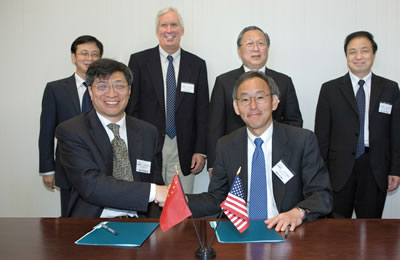
A delegation from the Chinese Academy of Sciences toured Berkeley Lab and UC Berkeley on July 13. During the visit Chen Hesheng, Director General of the Academy’s Institute of High Energy Physics, and Berkeley Lab Director Steve Chu signed a memorandum of understanding to strengthen existing ties between the two institutions in physics research. Looking on (from left) were Hou Jianguo, Executive Vice-President of the University of Science and Technology of China, Associate Laboratory Director James Siegrist, Lu Yongxiang, President of the Chinese Academy of Sciences, and Guo Huadong, the Academy’s Deputy Secretary General. A major part of the memorandum of agreement covers neutrino research at China’s Daya Bay (see the accompanying article).
Much as electron neutrinos created in the sun disappear on their way to Earth, some proportion of electron antineutrinos “disappear” about two kilometers away from where they are created in reactors, due to theta one three oscillation. The far detectors at Daya Bay will be positioned at this distance. Near and far detectors will be exchanged on a regular basis to cancel any systematic detector errors.
By knowing how many electron antineutrinos are produced in the reactors — on the order of a million quadrillion every second! — and the number expected to arrive at each detector — about a thousand per day at the nearby sites, a hundred a day at the far sites — and then comparing how many events are actually detected, a derivative of theta one three can be determined to a precision of better than 0.01.
Says Luk, “Basically it comes down to how many antineutrinos disappear.”
See the forthcoming issue of Science@Berkeley Lab for more on this story.
Barale Family Celebrates Three Generations at Berkeley
When Caitlin Barale told her grandfather she was working in Building 64 of Berkeley Lab, he wanted to know if she had his old office at the corner of the second floor. As it turns out, she’s in the adjacent one, where her father, Paul, had worked nearly thirty years before. She’d taken a job for the summer in the Life Sciences Division to pursue her interest in genetics. Now, she represents the third generation of her family to work at Berkeley Lab.
“It’s pretty amazing when you think we’ve been here for 56 out of 75 years. That’s more than two-thirds of the Lab’s history,” Caitlin said.
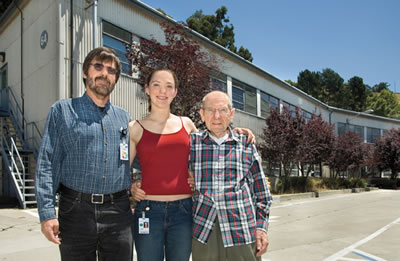
Three generations of the Barale family, Paul, Caitlin, and John, share their enthusiasm for Berkeley Lab and its science.
Grandfather John Barale joined Berkeley Lab as an electrical engineer in 1950 after gaining an interest and expertise in ham radios and radar from the U.S. Navy. On his watch, until his retirement in 1982, Berkeley Lab transitioned from vacuum tubes to transistors to the first laboratory-scale computers. He remembers the days of ticker tape and punch cards, which he used to run the Bevatron. Back then he counted scintillations by watching neon bulbs light up.
John’s son Paul chuckled when he recalled some of the stories his father used to tell him about life at Berkeley Lab, such as trouble with the bubble chamber.
“We were moving that bubble chamber all the time,” John reminisced.
Growing up, Paul noticed that his father returned home from his job happy and fulfilled, he said. When the opportunity came to work for Berkeley Lab in 1974, Paul signed on as an electrical engineer, just like his father. For four years father and son collaborated to maintain and upgrade equipment. During this time they occupied adjacent rooms in Building 64. It seemed appropriate that they collaborated and shared their interest of mechanical crafts, Paul said.
“Growing up we used to work on cars together,” he said. “It was a good fit,”
Much has changed since Paul and John worked together. Paul became one of the founders of the Real Time System Group, which develops control mechanisms for equipment. Currently he works at the Human Genome Institute in Walnut Creek. Caitlin uses the room her father once occupied to run DNA assays for genetics research. But she and her father Paul still have the opportunity to collaborate, Caitlin said.
“She gives me perspective,” Paul said. She fills him in on the details and lingo of genetics research while he gives her an appreciation and understanding of the complex equipment she uses.
The Barale family live only a few minutes from each other. During the summers, Caitlin, who studies at the University of California in Davis, comes home to stay with her father and mother.
“A lot families don’t get along together,” John mused. “We’ve always been very close.”
What attracted all three of them to the lab is the atmosphere, said John. “How wonderful it is to spend most of your time working in an exciting place, and with people who are intelligent and considerate, and actually get paid for it.”
Snap Shot: An inside look at one of the Lab’s many interesting employees…

Name:
Linda Smith
Job:
Department Head, IT Infrastructure, IT Division
Childhood Ambition:
Classical Concert Pianist
Weirdest Job:
Making blood transfusion bags during the summer at Cutter Laboratory
Guilty Pleasure:
Banana Splits
Hero:
My Mom
Proudest Moment:
Getting my first job
Last Book Read:
Jazz, By Toni Morrison
Current Tunes on iPod or CD Player:
The Songs Live On, By Joe Sample, Featurin Lalah Hataway
Favorite Movie(s):
Glory
When Not Working:
Playing my piano, movies, plays, reading
Ideal Vacation:
Relaxing in the Carribean.
Berkeley Lab View
Published once a month by the Communications Department for the employees and retirees of Berkeley Lab.
Reid Edwards, Public Affairs Department head
Ron Kolb, Communications Department head
EDITOR
Pamela Patterson, 486-4045, pjpatterson@lbl.gov
Associate editor
Lyn Hunter, 486-4698
STAFF WRITERS
Dan Krotz, 486-4019
Paul Preuss, 486-6249
Lynn Yarris, 486-5375
CONTRIBUTING WRITERS
Jon Bashor, 486-5849
Allan Chen, 486-4210
David Gilbert, (925) 296-5643
DESIGN
Caitlin Youngquist, 486-4020
Creative Services Office
PHOTOGRAPHY
Roy Kaltschmidt, 486-5731
Creative Services Office
Berkeley Lab
Communications Department
MS 65, One Cyclotron Road, Berkeley CA 94720
(510) 486-5771
Fax: (510) 486-6641
Berkeley Lab is managed by the University of California for the U.S. Department of Energy.
Online Version
The full text and photographs of each edition of The View, as well as the Currents archive going back to 1994, are published online on the Berkeley Lab website under “Publications” in the A-Z Index. The site allows users to do searches of past articles.
Flea Market is now online at www.lbl.gov/fleamarket.
Front Seat to History: Summer Lecture Series Kicks Off
This year’s series of summer lectures celebrates the 75th anniversary of Berkeley Lab. The first four of six lectures packed nearly full houses and will be aired on UC TV. The remaining two are Andy Sessler on Particle Accelerators on Wednesday July 26 and Darleane Hoffman on the discovery of trans-uranium elements on Wednesday August 2.
The Death of the Dinosaurs — 27 Years Later
It’s been 27 years since the team led by Nobel Laureate Luis Alvarez and his son Walter theorized that a meteor the size of San Francisco struck the Earth 62 million years ago, exterminating 99.9 percent of all species. According to their theory, the event, called the KT extinction, heralded a dramatic end to the age of dinosaurs and hailed the rise of mammals. New research continues to support the theory but also raises more questions.
Richard Muller, an astrophysicist, was one of Luis Alvarez’s graduate students. He recalled the genesis of the theory when, in 1979, Walter Alvarez asked his father’s help to study a layer of iridium in the mountains of Italy. Collaborating with Berkeley Lab’s Frank Asaro and Helen Michel, the Alvarezes speculated that the iridium in the layer came from a meteor or comet, since iridium is rare on the Earth’s surface but abundant in celestial bodies. They dated the layer to the same period as the KT extinction and concluded that a meteor had struck and sprayed iridium dust into the air. Since then, scientists have found a crater large enough to accommodate the impact in Mexico.
Muller believes the KT extinction could be part of a cycle of extinctions occurring every 26 million years, coinciding with meteor showers. These periodic bombardments might be linked to a companion star to the sun called “Nemesis”, which Muller hypothesized passes through the solar system at these intervals. Scientists now know less than they did 27 years ago, but, concluded Muller, that’s progress in scientific terms.
Nuclear Medicine at Berkeley Lab: From Pioneering Beginnings to Today
Berkeley Lab’s rich history of innovation includes the birth of the field of nuclear medicine, said physician and physicist Thomas Budinger, head of the Lab’s Center for Functional Imaging. Founder Ernest Lawrence invited his brother John Lawrence to join him in 1936. John Lawrence, a physician who saw the potential for using cyclotrons in medicine, founded the Donner Laboratory to pursue his research with radioisotopes. In 1937, he used a radioisotope of phosphorus-32 to treat a bone marrow disorder.
Physicists at Berkeley Lab used particle accelerators to develop many novel radioisotopes, many still used in medicine today. Nobel Laureate Glenn Seaborg created iodine-131. In 1938, John Hamilton used the isotope at Berkeley Lab to perform the first test of metabolism, documenting the element’s path through the body to collect in the thyroid. Nobel Laureates Emilio Segrè and Seaborg discovered technicium 99m, now the most commonly used radioisotope in medicine.
John Lawrence also used ion beams from particle accelerators to eliminate tumors without surgery in 1939. Since then, ion beams, accurate to millimeters, have been used to treat brain tumors and disorders, and arteriovenous malformations.
In 1957 Berkeley Lab’s Hal Anger developed the first gamma-ray camera, a device still used today, which creates an image by marking the distribution of radioisotopes in the body. Budinger developed an extremely high resolution PET scanner in 1986, which he has used to study such diseases as Alzheimer’s and Parkinson’s, and he conducts research on the effects of cosmic radiation on astronauts.
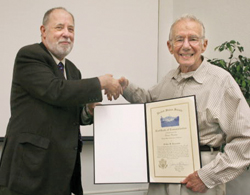
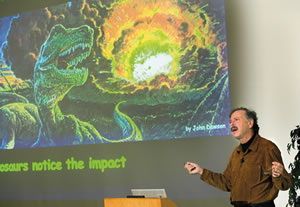
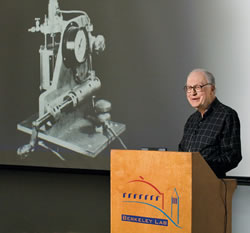
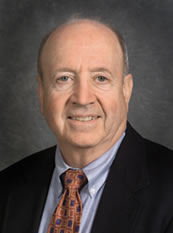
Graham Fleming, top left, presents Art Rosenfeld with a congressional certificate in recognition of his Fermi Award; Richard Muller discusses the death of the dinosaurs; Donald Glaser, bottom left, with an early image of the bubble chamber; and Thomas Budinger, bottom right, head of the Lab’s Center for Functional Imaging.
Energy Efficient Buildings and Appliances: From Berkeley Lab to the Market Place
Prior to his lecture, energy conservation guru and California’s energy commissioner Art Rosenfeld received a congratulatory letter from the U.S. Congress, presented by Berkeley Lab’s Executive Director Graham Fleming, for earning the 2005 Fermi Award, the country’s oldest and most prestigious award for scientific achievement. Rosenfeld, who began as a physicist, changed fields after the energy crisis of 1973. In 1975 he founded Berkeley Lab’s Center for Building Science which researches energy saving strategies and technologies.
“The first thing to do is to go for better energy efficiency,” Rosenfeld said. Using a graph, he demonstrated how the rate of U.S. energy consumption dropped in the year 1973. The nation will spend $700 billion less in 2006 than it would have had the pre-1973 rate of consumption continued, he said. About a third of the amount can be attributed to improvements in transportation, a third to structural changes, and another third to buildings and industry improvements.
The energy savings have had a tremendous environmental impact as well a fiscal one. The amount of carbon conserved by the reduced energy use is equivalent to taking one billion cars off the road, he said.
In California, energy use per person has remained about the same for the last thirty years. Rosenfeld remains optimistic that we can conserve even more. He predicted global warming to be the issue that drives energy efficiency in the decades to come. “I think we will see more and more states paying attention,” he said.
Invention and History of the Bubble Chamber
During his talk, Donald Glaser put an end to the rumor that bubbles in beer inspired him to create the bubble chamber, which allows physicists to track electrically charged particles, and which won Glaser the 1960 Nobel Prize.
However, he did consider using beer at one point, Glaser said. He developed the concept for the bubble chamber while at Ann Arbor, Michigan, working with his advisor, Nobel Laureate Carl Anderson. Glaser’s device used glass bulbs filled with liquid. By submerging the bulbs first in cold oil and then in hot oil, he could superheat the liquid. In that state, the liquid is full of potential energy. A charged particle passing through would have enough energy to trigger bubbling and leave a visible trail. A fast action camera would photograph the trail the instant before the liquid began to boil over, providing an image physicists could use. However, Glaser needed a liquid with a low enough surface tension. Too high, and the liquid would not bubble even if a energized by a charged particle.
His experiments with beer left nothing but a stench in the room and raised a few eyebrows, he said. Instead, he filled the tubes with diethyl ether. Later bubble chambers increased in size and used liquid hydrogen.
Glaser is now a professor of physics and neurobiology, at UC Berkeley’s graduate school. He’s developing computational models of human vision. His graduate lab is a haven for “refugees of high energy physics,” like him, he said.
Anne Pinckard graduated from the UC Santa Cruz Science Communication Program and is an intern in the Communications Department.
Shank’s First Years: Fundamental Research and National Needs
A legacy of achievement: Top Quark and Relics of the Universe
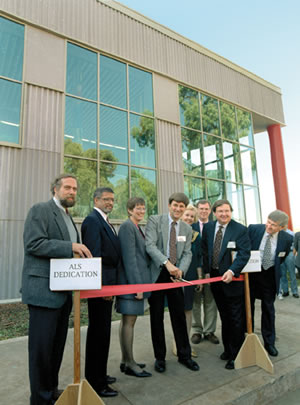 ALS dedication with (left to right) Jay Marx, Don Perlman, Martha Krebs, David Shirley, Gail Wilson (Governor’s wife) Brian Kincaid, Charles Shank (director of LBL) and Hermman Grunder
ALS dedication with (left to right) Jay Marx, Don Perlman, Martha Krebs, David Shirley, Gail Wilson (Governor’s wife) Brian Kincaid, Charles Shank (director of LBL) and Hermman Grunder
Charles Shank became the fifth director of Berkeley Lab on September 1, 1989. He was the first director from outside the Lab, coming to the Lab after a 20-year career at AT&T Bell Laboratories, where he made pioneering contributions to the study of ultrafast laser pulses and fiber-optic communications.
His background in cutting-edge science that quickly found a home in the private sector shaped his leadership style. He viewed national labs, and Berkeley Lab in particular, as a place to conduct fundamental research and a place to incubate technologies that could improve the competitiveness of U.S. industry and the quality of people’s lives.
This approach was summed up in a March 18, 1989 San Francisco Chronicle article, in which Shank looked forward to his directorship: “I feel I bring a view of what the industrial needs are for research, and how we can use that to have impact on the nation’s problems of competitiveness.”
Specifically, Shank believed that by focusing on long-term, precompetitive technologies, the government can help foster U.S. industry — an important boost given that many facets of the U.S. high-tech industry had slipped behind foreign competitors by the late 1980s.
Shank also took over at a time when Berkeley Lab was moving away from its flagship enterprises of basic research in physics and chemistry and toward biomedicine, materials sciences, and energy efficiency research. Indeed, the Chronicle article adds that “His appointment seems tailored to strengthen the lab’s recent focus on basic research in electronics and materials. This is a trend away from the atomic physics and accelerator technologies that made the lab famous through the 1960s.”
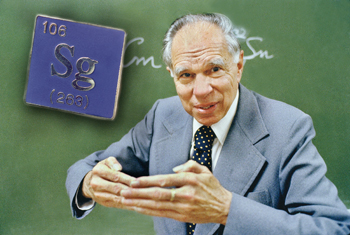 Glenn Seaborg with Seaborgium pin
Glenn Seaborg with Seaborgium pin
The bridge between fundamental research and research that can benefit humanity in short order was best embodied in a new facility that drew Shank’s interest from the start. The Chronicle article states that “Shank said that one ‘wonderful’ lure at Berkeley Lab is a new machine, the Advanced Light Source [ALS], due to be finished in 1993.”
The ALS, a national user facility that generates intense light for scientific research, was the world’s first third-generation synchrotron light source in its energy range. Ground was broken for the ALS, which is actually housed in the iconic dome-shaped building of Ernest Lawrence’s 184-Inch Synchrocyclotron, in 1988. Construction of the ALS was led by Jay Marx, a physicist who had directed the PEP-4 project, one of the largest particle physics experiments of its time.
“We tried to be realistic from the start about how long it would take to build the ALS and how much it would cost,” Marx once told an interviewer. He and his group succeeded magnificently, bringing the ALS project in ahead of schedule by about three days, and about $2,000 under its $100 million budget.
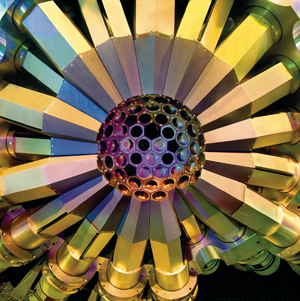 The Gammasphere
The Gammasphere
The ALS was commissioned in March of 1993 and the official dedication took place in October, 1993. At that dedication, Shank cited six people whose contributions were critically important to the project’s completion: Jay Marx, David Attwood, Ron Yourd, Alan Jackson, Klaus Halbach, and Klaus Berkner.
By 1995, the ALS was overcommitted to users on its existing twelve beamlines, so it opened five more beamlines in 1996. That same year, to address national needs for instrumentation in macromolecular and subcellular structure determination, the ALS launched programs in materials research, chemical dynamics, and structural biology.
The opening of the ALS was big news, at least for the Lab and the scientists worldwide who lined up to use the state-of-the-art facility. But it didn’t land anybody on Jay Leno’s latenight talk show. For that, one has to find the relics of the primeval explosion that began the universe. In April, 1992, a team led by Berkeley Lab astrophysicist George Smoot did just that. These relics, the largest structures ever observed in the universe, appear as “hot” and “cold” regions with temperature differences of a hundred-thousandth of a degree.
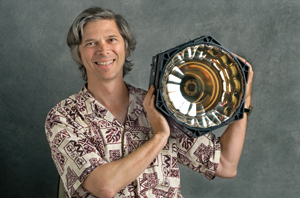 Kevin Lesko with SNO photomultiplier tube
Kevin Lesko with SNO photomultiplier tube
Smoot said the relics are believed to be the primordial seeds that grew into present-day galaxies. More than 100 million light years across, these regions were discovered after Smoot’s team analyzed data from NASA’s Cosmic Background Explorer satellite. Using this data, Smoot’s team created maps of the sky showing vast regions of space with minuscule temperature variations. The variations had been predicted by theorists but, up until Smoot and his team found evidence of them, they had never been detected.
Their discovery was splashed across headlines. It also made Smoot something of a celebrity, at least for a few days. He was a guest on Leno and he appeared in People Magazine (with Madonna on the opposite page). A more suitable and less flash-in-the-pan honor came the following year, when Smoot was named one of the winners of the 1994 E.O. Lawrence Award.
Berkeley Lab’s role as a leader in life science research was bolstered in 1992, when Lab scientists discovered a gene that predisposes people to atherosclerosis, the leading cause of heart disease in this country. Designated ATHS (for atherosclerosis susceptibility), the gene was located on chromosome 19. Berkeley Lab’s Ronald Krauss discovered the gene in collaboration with researchers from the Children’s Hospital Oakland Research Institute.
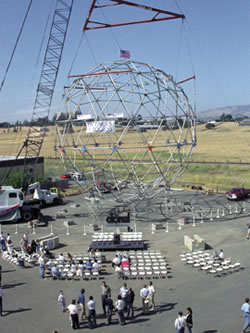 Scaffolding for the Sudbury Neutrino Observatory (SNO), Petaluma CA
Scaffolding for the Sudbury Neutrino Observatory (SNO), Petaluma CA
Yet another milestone came in July, 1993, when Berkeley Lab celebrated the completion of the 18-meter geodesic sphere that was to be a major component of the Sudbury Neutrino Observatory (SNO). The facility, located in a cavern more than a mile underground in Canada, is a collaboration involving institutions in the U.S., Canada, and the United Kingdom. Its mission is to study neutrinos, the ghostlike particles emitted from the sun and other cosmic and man-made sources.
Berkeley Lab’s contribution to the project was spearheaded by a team from the Nuclear Science and Engineering divisions under the leadership of physicist Kevin Lesko. The team developed the panel arrays that housed thousands of the extremely sensitive light-detectors called photomultiplier tubes. Using these arrays, SNO became the first detector sensitive enough to measure both ordinary electron neutrinos and the much rarer muon and tau neutrinos.
Also in 1994, Element 106 was named “seaborgium” in honor of Nobel Laureate and Associate Director-at-Large Glenn T. Seaborg. It was discovered at Berkeley Lab in 1974 by Lab physicist Albert Ghiorso and Lawrence Livermore National Lab chemist Kenneth Hulet, who named it in honor of Seaborg. The element was confirmed at Berkeley Lab in 1993 in an experiment at the 88-Inch Cyclotron led by Ken Gregorich and Darleane Hoffman of the Nuclear Science Division. The controversial move to name the element after the great chemist marked the first time an element had been named for a living person.
But the biggest breakthrough came on April 26, 1994, when an international collaboration of physicists, including a Berkeley Lab team, announced the first experimental evidence for the subatomic particle known as the top quark.
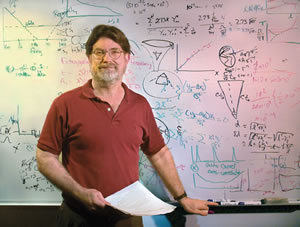 George Smoot
George Smoot
The experiment was carried out at Fermi National Accelerator Lab-oratory’s Tevatron by the Collider Detector at Fermilab (CDF) collaboration. The existence of the top quark is required by the Standard Model, which holds there are six quarks that combine to form composite particles, such as protons and neutrons. The fifth of these six, called the bottom quark, was discovered at Fermilab in 1977. Scientists had been searching for its partner, the top quark, ever since.
An essential contribution to the experiment came from Berkeley Lab physicists and engineers who designed a microchip for the Silicon Vertex Detector, an extremely high resolution instrument at the heart of the CDF array that enabled precise identification and tracking of bottom quarks.
“We were confident that we would eventually find the top quark,” said Lina Galtieri in a press release on the achievement. She was a physicist who headed the CDF group at Berkeley Lab. Galtieri’s group also analyzed the CDF data to determine the mass of the top quark candidates. This analysis was based on a technique developed at Berkeley Lab in the 1960s by the research group led by the late Nobel laureate Luis Alvarez.
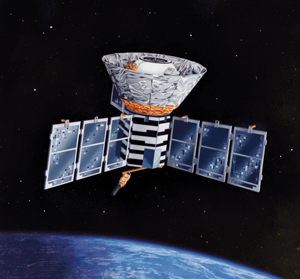 The Cosmic Microwave Background Explorer (COBE)
The Cosmic Microwave Background Explorer (COBE)
Importantly, the CDF group’s finding was independently corroborated by a second detector at the Tevatron called DZero, which is also a multi-institutional experiment. The DZero group at Berkeley Lab, led by Ron Madaras, was responsible for designing, building, and commissioning two critical components of the DZero detector array: the Electromagnetic End Calorimeter, which identifies and measures the energies of electrons; and the Vertex Detector, which detects the tracks left by charged particles.
In a March 2, 1995 Fermilab symposium, the CDF and DZero groups announced that they had tripled the amount of data collected since the earlier announcement, confirming the existence of the particle.
“This is one of the ten most important accomplishments in this century in this field,” said Tom Trippe at the time. Trippe is a physicist in the Physics Division and a member of the DZero group.
Berkeley Lab scored another major national user facility in November, 1995, when DOE’s Office of Energy Research announced that it had selected the Lab as the site of a new high-performance computing center. In a November, 1995 Currents article, Shank underscored the importance of the center to the future of Berkeley Lab. “We have an unprecedented opportunity to integrate science and computing to fully realize the value of high performance computing for the scientific programs of the nation,” he said. “This has the potential to transform the way we do science in virtually every part of the Laboratory.”
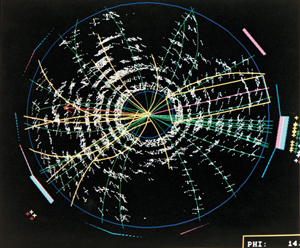 Electronic signatures revealing top quark, produced by collisions of protons and antiprotons in the Tevatron accelerator at Fermilab
Electronic signatures revealing top quark, produced by collisions of protons and antiprotons in the Tevatron accelerator at Fermilab
Indeed, when the center came to Berkeley Lab in May, 1996, it was named the National Energy Research Scientific Computing Center (NERSC), and forever changed the Lab’s research portfolio. Early users of NERSC’s six CRAY supercomputers included teams of scientists tackling grand challenges ranging from treating nuclear waste, understanding the human genome, studying the Big Bang, and creating the next generation of particle accelerators.
In the fall of 1995, Berkeley Lab started construction of a new Human Genome Laboratory, building 84, which was located near buildings 74 and 83 to form a cluster of life sciences research laboratories. The building brought together all of the research teams that made up Berkeley Lab’s Human Genome Center (now part of the DOE Joint Genome Institute, which was established in 1997 in Walnut Creek). The building also marked a milestone in the history of the Human Genome Project, the national effort to decipher the human genetic code spearheaded by DOE and the National Institutes of Health. Ultimately, Berkeley Lab’s genome scientists (working at the Joint Genome Institute) went on to sequence human chromosomes 5, 16, and 19, which together constitute some 11 percent of the human genome.
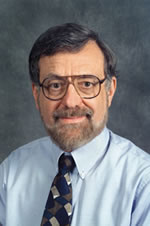 Ron Krauss
Ron Krauss
As 1995 drew to a close, the Lab welcomed one more major research tool. On December 1, the world’s most powerful instrument for detecting gamma rays, the Gammasphere, was dedicated. The purpose of the Gammasphere was to enable scientists to observe gamma radiation emitted by rapidly spinning atomic nuclei. Such observations yield information on nuclear structure that could not be obtained from conventional studies.
Along with these changes in the Lab’s research landscape came a change in the Lab’s name. On June 16, 1995, after receiving approval from the University of California Board of Regents, the lab added the word “national” to its name, becoming Ernest Orlando Lawrence Berkeley National Laboratory, or Lawrence Berkeley National Laboratory for short. The change was made to reflect the Lab’s commitment to respond to national scientific needs, as well as to project a more distinctive identity to decision-makers in Washington. The change was also intended to distinguish the Lab from two other East Bay science facilities named after Lawrence — Lawrence Livermore National Laboratory and the Lawrence Hall of Science.
Next month: The second half of Shank’s directorship.
Berkeley Lab Science Roundup
Molecular Dna Switch Found To Be The Same For All Life
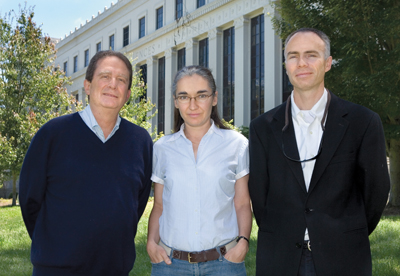 Research led by Michael Botchan (left), Eva Nogales and James Berger revealed that the molecular machinery behind the initiation of DNA replication in biological cells is remarkably similar for all forms of life on Earth.
Research led by Michael Botchan (left), Eva Nogales and James Berger revealed that the molecular machinery behind the initiation of DNA replication in biological cells is remarkably similar for all forms of life on Earth.
Berkeley Lab’s Eva Nogales of the Life Sciences Division, and James Berger of the Physical Biosciences Division, led studies whose results indicate that the molecular machinery that initiates the process by which a biological cell divides into two identical daughters is the same for all life on Earth. In papers that will be featured on the cover of the August issue of Nature Structural and Molecular Biology, they report the identification of a helical substructure within a superfamily of proteins, called AAA+, as the molecular “initiator” of DNA replication in a bacteria, Escherichia coli (E. coli), and in a eukaryote, Drosophila melanogaster, the fruit fly. Taken with earlier research that identified AAA+ proteins at the heart of the DNA replication initiator in archaea, these new findings indicate that DNA replication is an ancient event that evolved millions of years ago, prior to when Archaea, Bacteria and Eukarya split into separate domains of life.
Data for the E. coli study, which was led by Berger, came from a protein crystallography beamline (Beamline 8.3.1) at Berkeley Lab’s Advanced Light Source. Data for the fruit fly study, led by Nogales and UC Berkeley biochemist Michael Botchan, was obtained through electron microscopy.
First Direct Observations Of Spinons And Holons
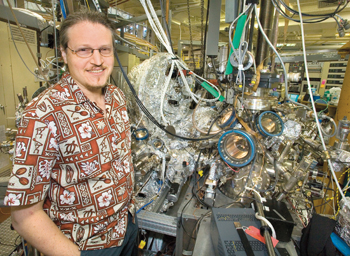
Eli Rotenberg at ALS Beamline 7.0.1, home to the Electron Structure
The spin and electrical charge of an electron are thought to be intrinsic parts of a whole, like the body and wheels of a car, incapable of separate and independent actions. However, according to a 40-year-old theory, certain conditions in a one-dimensional solid can lead to the separation of spin and charge into two new particles called “spinons” and “holons.” A team of scientists working at Berkeley Lab’s Advanced Light Source (ALS), which included ALS scientist Eli Rotenberg, has obtained the first direct and unambiguous proof that the theory is correct. In a paper published in the journal Nature-Physics, Rotenberg and his colleagues reported the observation of distinct spinon and holon spectral signals in one-dimensional samples of copper oxide, SrCuO2, using the technique known as ARPES, for angle-resolved photoemission spectroscopy.
A spinon carries information about an electron’s spin and a holon carries information about its charge, and they do so as separate and independent entities. Numerous experiments have tried to confirm the creation of spinons and holons, referred to as spin-charge separation, but it took the technological advantages offered at ALS Beamline 7.0.1, also known as the Electronic Structure Factory, to achieve success.
Life Cycle Of Operons Yields New Look At Bacterial Genetics
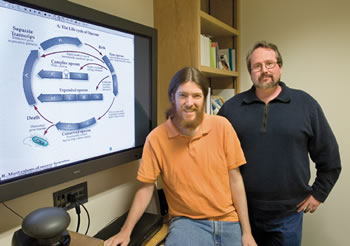
Morgan Price (left) and Adam Arkin have created a model that provides a framework for understanding the evolutionary life-cycle of operons, small groups of genes with related functions that are co-transcribed in a single strand of messenger RNA.
In a breakthrough that will immediately benefit biologists who study bacteria, a team of researchers led by Adam Arkin, a computational biologist in Berkeley Lab’s Physical Biosciences Division, and including Morgan Price, has determined the life cycle of operons, small groups of genes with related functions that are cotranscribed in a single strand of messenger RNA. In the future this research could also have bearing on the advancement of the emerging field of synthetic biology, in which microbes are genetically engineered to make specific products, such as new medicines or pharmaceutical drugs. Present in all known bacterial genomes, operons play a crucial role in gene expression programs that enable microbes to adapt to environmental stresses. In a paper published in the Public Library of Science, Adams and his collaborators describe a study in which the genome of Escherichia coli was compared to Salmonella typhimurium and other close relatives, in order to identify recently formed and destroyed operons. The results showed that both operon creation and destruction lead to large changes in gene expression patterns, suggesting that operon evolution reflects a microbe’s adaptation to differing lifestyles.
Quantum Dots Pose Minimal Impact To Cells
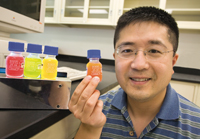
Frank Chen holds a bottle of quantum dots.
Nano-sized fluorescent probes that can slip inside living cells and elucidate life’s most fundamental processes, or track the effectiveness of cancer-fighting drugs, are barely noticed by the cells they enter, according to a team of researchers led by Frank Chen, a chemist in Berkeley Lab’s Life Sciences Division. Using a high-throughput gene expression test, Chen and his team analyzed the effects on cells of specially coated quantum dots, crystalline semiconductors composed of a few hundred or thousand atoms that emit different colors of light when illuminated by a laser. They determined that these fluorescent probes only affect 0.2 percent of the human genome. This finding should quell concerns that the mere presence of these promising but potentially toxic sentinels disrupts a cell’s function, confounding quantum dots’ ability to accurately track cellular processes or monitor the effectiveness of pharmaceuticals. The tool used by Chen and colleagues to analyze quantum dots — a gene chip packed with 18,400 probes of known human genes — is one of the world’s most comprehensive and streamlined ways to measure the toxicity of nanoscale particles. Berkeley Lab is one of the first to conduct and publish studies on high-throughput, whole-genome analyses of the toxicity of nanoparticles.
— Lynn Yarris
International Prizes in Physics and Astronomy Honor Saul Perlmutter
The Shaw Foundation in Hong Kong awarded its first scientific prizes in 2004. The Lincei Academy in Rome was founded over 400 years ago and counts Galileo Galilei among its earliest members. Both have honored Saul Perlmutter for his leadership in discovering the accelerating expansion of the universe.
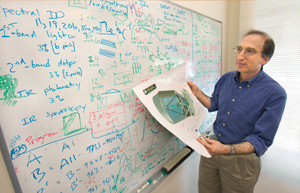
Saul Perlmutter is a leader of the SNAP satellite project to investigate dark energy.
The Lincei Academy’s Antonio Feltrinelli Prize is regarded as Italy’s highest scientific and cultural award. Prizes in the Arts, Letters, Medicine, Moral or Historical Sciences, and Physical and Mathematical sciences rotate annually. Four prizes go to residents of Italy, with Perlmutter the sole winner of this year’s International Prize.
Shaw Prizes, established by movie producer and philanthropist Sir Run Run Shaw, are awarded annually in Astronomy, Mathematics, and Life Sciences and Medicine. Perlmutter, with Adam Riess of Johns Hopkins University and Brian Schmidt of the Australian National University, his sometime rivals and occasional collaborators, shares this year’s Astronomy prize.
Perlmutter founded the international Supernova Cosmology Project with Carl Pennypacker in 1988; Schmidt was leader and Riess a member of the High-Z Supernova Search Team, which adopted the SCP’s pioneering methods for finding distant supernovae on demand.
Early in 1998 both teams announced their astonishing discovery that universal expansion is not slowing, as everyone assumed. What’s pushing galaxies apart ever faster has a name, dark energy, but its nature is regarded as the most compelling problem of 21st-century physics.
When Perlmutter learned of the Shaw Prize co-winners, he said, "That there are three co-winners underscores how such work is dependent on the teams’ efforts and on the community of scientists that they are a part of.”
The Shaw Prizes will be given out at a ceremony in Hong Kong on September 12. The Feltrinelli Prizes will be awarded in Rome on November 10. Both come with substantial cash awards.
Fabulous Fun at Founders Day
Employees and retirees, along with their friends and family, are invited to a celebration of the Lab’s 75th birthday on Saturday, Aug. 26, from 10 a.m. to 3 p.m.
Numerous activities are planned for the day. Entertainment includes R&B music by the Lab Band, original rock tunes by Copper Dome Bodhi, featuring EETD staffer Julia Turner, and fire dancing by nuclear scientist Sarah Nelson.
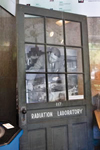
Guests can also watch vintage films from 1931, the year the Lab was founded, participate in a ping pong match, enjoy a barbecue lunch prepared by the cafeteria, tour the Advanced Light Source, or take in a historical exhibit in the Building 50 lobby.
The kids will enjoy bouncing around in an inflatable jumper, participating in hands-on science experiments, or learning about the Lab by tracking down clues for a passport treasure hunt.
At a noontime ceremony, Director Steve Chu will dedicate a time capsule, full of items recommended by employees to commemorate the Lab’s 75th year. Tours, information tables, an arts and crafts fair, and a classic car show round out the agenda.
Send e-mail to foundersday@lbl.gov to RSVP for this exciting event. Those wishing to volunteer their help can contact Lyn Hunter at x4698 or lhunter@lbl.gov.
Check Today at Berkeley Lab for updates on Founders Day.
People, Awards, and Honors

Life Scientist Receives Young Investigator Award
Rostyslav Boutchko, with Thomas Budinger’s Nuclear Medicine and Functional Imaging Department (Life Sciences), won the Computer and Instrumentation Council Young Investigator Award at the recent Society of Nuclear Medicine Annual Meeting in San Diego. The title of his talk was “Three-Dimensional Reconstruction of Dynamic Cardiac SPECT Data on a Point Cloud Grid.” Boutchko, along with Arkadiusz Sitek and Grant Gullberg, are developing a multiresolution grid approach to image reconstruction, which may bring forth improvements in data processing, 3D display, and diagnostic quality of medical images and provide direct segmentation and finite element mesh specification for mechanical and electrical modeling of the heart.

Indoor Environment Expert Honored
Max Sherman, with the Lab’s Environmental Energy Technologies Division, Indoor Environment Department, recently received the Louise and Bill Holladay Distinguished Fellow Award for continuous preeminence in engineering and research work. The award was presented by the American Society of Heating, Refrigerating and Air- Conditioning Engineers (ASHRAE) during their annual meeting last month. Sherman is an ASHRAE fellow and leader of the Energy Performance of Buildings Group.

Public Affairs Head Chairs Chamber of Commerce
Reid Edwards, head of Berkeley Lab’s Public Affairs Department, has been chosen as the new chairman of the Oakland Metropolitan Chamber of Commerce Board of Directors. Edwards has served on the Oakland board since 2000. He previously served as chairman of the board for the Berkeley Chamber of Commerce from 2000 to 2003.

HPCwire Names Kathy Yelick a Person to Watch
Kathy Yelick of Berkeley Lab’s Computational Research Division has been named to this year’s “People to Watch” list by HPCwire, the international publication of record for all aspects of the high performance computing industry. HPCwire publishes its “People to Watch” list annually to recognize “the most influential, interesting and promising personalities having an impact on the world of High Performance Computing.” Yelick was chosen for her contributions to the development of the Titanium language, and her involvement in the design of Unified Parallel C (UPC).